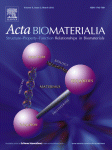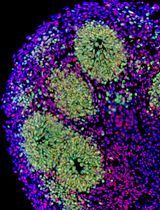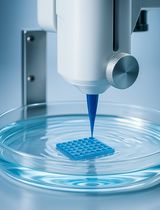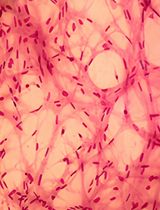- EN - English
- CN - 中文
A Streamlined Method for the Preparation of Growth Factor-enriched Thermosensitive Hydrogels from Soft Tissue
从软组织中制备富含生长因子的温敏性水凝胶方法
发布: 2017年02月05日第7卷第3期 DOI: 10.21769/BioProtoc.2128 浏览次数: 8904
评审: Antoine de MorreeFederica PisanoAnonymous reviewer(s)
Abstract
Hydrogels are an ideal medium for the expansion of cells in three dimensions. The ability to induce cell expansion and differentiation in a controlled manner is a key goal in tissue engineering. Here we describe a detailed method for producing hydrogels from soft tissues with an emphasis on adipose tissue. In this method, soluble, extractable proteins are recovered from the tissue and stored while the remaining insoluble tissue is processed and solubilised. Once the tissue has been sufficiently solubilised, the extracted proteins are added. The resulting product is a thermosensitive hydrogel with proteins representative of the native tissue. This method addresses common issues encountered when working with some biomaterials, such as high lipid content, DNA contamination, and finding an appropriate sterilisation method. Although the focus of this article is on adipose tissue, using this method we have produced hydrogels from other soft tissues including muscle, liver, and cardiac tissue.
Keywords: Hydrogel (水凝胶)Background
The main goal of tissue engineering is to generate new tissue by providing the body with a scaffold possessing similar properties to those of the target site. This allows for optimal remodeling and enables formation of de novo endogenous tissue. In the field of adipose tissue engineering, biomaterials derived from adipose tissue are of particular interest because adipose tissue is widely available and in theory provides the best possible environment for induction of adipogenesis (Flynn et al., 2007; Flynn, 2010; Uriel et al., 2008; Choi et al., 2009; Young et al., 2011). It has been established that adipocytes secrete adipogenic factors (Li et al., 1998; Shillabeer et al., 1989; Shillabeer et al., 1990) and that conditioned medium produced from either adipocytes or excised adipose tissue is able to induce adipogenesis in vitro (Sarkanen et al., 2012).
The development of an injectable hydrogel with properties closely matching those of healthy adipose tissue would potentially be of great use in regenerative medicine. The ideal hydrogel would be acellular, contain proteins that are representative of those found in natural adipose tissue, be structurally capable of maintaining a space after implantation, and be capable of inducing adipose tissue growth (Cheung et al., 2014; Drury and Mooney, 2003). We have previously reported on the production of a thermoresponsive hydrogel from excised adipose tissue which was shown to be adipogenic both in vitro and in vivo (Poon et al., 2013). The gel induced adipogenic differentiation of adipose-derived stem cells in vitro and was capable of producing adipose tissue from 8 weeks post-implantation in the subcutaneous layer of the rat back (Debels et al., 2015).
As originally reported, our adipose-derived hydrogel used dispase to decellularise the tissue prior to extraction. Although dispase is capable of efficiently decellularising tissue (Uriel et al., 2008; Prasertsung et al., 2008), we have since observed the degree of digestion varies greatly from batch to batch due to differences in tissue surface area. Additionally, the slight differences in decellularisation led to variations in lipid content between batches which altered protein extraction efficiency and clarity of the final product. The washing and delipidation steps were also of concern as they increased variation of the gel’s final physical properties. Since our original publication, we have developed a practical and efficient method to replace these early processes.
Here we provide a detailed protocol for producing a soft tissue-derived hydrogel which addresses many of these concerns and reduces batch-to-batch variability. In our new method, proteins are extracted from the tissue first in order to retain as much soluble protein as possible for subsequent re-addition. Decellularisation by dispase digestion has been replaced with cold homogenisation and nuclease treatment. Dispase is capable of efficiently decellularising tissue; it works by cleaving fibronectin and collagen IV, but there is a problem, these proteins may provide important functional groups which would otherwise be lost after dispase digestion (Gregoire et al., 1998; Khoshnoodi et al., 2008). Delipidation is no longer performed over the course of multiple salt washes and centrifugation steps, now it is done as part of the homogenisation and solubilisation steps. This method has been used to successfully produce thermoresponsive hydrogels from multiple tissues including skeletal muscle and organs such as the liver and heart. These hydrogels containing a collection of soluble proteins present in the native tissues may provide others in the field the basis for further developments in biomaterials research.
Materials and Reagents
- Whatman glass fibre filter paper (Sigma-Aldrich, catalog number: WHA1820021 )
- Spectrum Laboratories 12-14 kDa dialysis membrane (Pacific Laboratory Products, catalog number: 132706 )
- Freshly harvested subcutaneous porcine adipose tissue, liver, skin, cardiac tissue, and visceral fat (Donated by Diamond Valley Pork [Laverton North, VIC, Australia])
Note: All tissue not used immediately was stored at -20 °C. - Human tissues (Collected from fully consented patients with ethics approval from the St Vincent’s Hospital Melbourne Human Research Ethics Committee [Protocol 52/03])
Note: All tissue not used immediately was stored at -20 °C. - Protease inhibitors (Sigma-Aldrich)
- Ammonium sulphate (Sigma-Aldrich, catalog number: 31119 )
- 70% ethanol (Sigma-Aldrich)
- Spectrum Laboratories Spectra/Gel Absorbent (Pacific Laboratory Products, catalog number: 292600 )
- PBS (Thermo Fisher Scientific, GibcoTM, catalog number: 10010023 )
- DNeasy Blood & Tissue Kit (QIAGEN, catalog number: 69504 )
- PierceTM BCA Protein Assay Kit (Thermo Fisher Scientific, Thermo ScientificTM, catalog number: 23225 )
- Dulbecco’s modified Eagle medium (Sigma-Aldrich, catalog number: D5796 )
- Fetal calf serum (CSL, Australia)
- Antibiotics
- Oil Red O (Sigma-Aldrich, catalog number: O0625 )
- Haematoxylin
- Collagenase I
- 4% paraformaldehyde or 10% neutral-buffered formalin
- Ethylenediaminetetraacetic acid (EDTA) (Sigma-Aldrich, catalog number: 798681 )
- N-ethylmaleimide (NEM) (Sigma-Aldrich, catalog number: E3876 )
- Benzamidine hydrochloride hydrate (Sigma-Aldrich, catalog number: B6506 )
- Urea (Sigma-Aldrich, catalog number: U1250 )
- Guanidine hydrochloride (GuHCl) (Sigma-Aldrich, catalog number: 50950 )
- Glacial acetic acid (Sigma-Aldrich)
- Tris base (Sigma-Aldrich, catalog number: RDD008 )
- NaCl
- DNase I (Roche Diagnostics, catalog number: 11284932001 )
- RNase A (Roche Diagnostics, RNASEA-RO )
- MgCl2
- Zinc sulfate heptahydrate (ZnSO4·7H2O) (Sigma-Aldrich, catalog number: Z0251 )
- Chloroform (Sigma-Aldrich)
- Methanol (Sigma-Aldrich)
- Pepsin (Worthington Biochemical, catalog number: LS003317 )
- Solutions (Prepared according to the directions outlined in Recipes)
- 0.5 M ethylenediaminetetraacetic acid (EDTA)
- 50 mg/ml N-ethylmaleimide (NEM)
- 50 mg/ml benzamidine hydrochloride hydrate
- 8 M urea
- 8 M guanidine hydrochloride (GuHCl)
- 0.5 N acetic acid
- 4 M GuHCl extraction buffer
- 10x Tris-buffered saline (TBS)
- Nuclease solution
- 1,000x haemoglobin precipitation solution
- Chloroform-methanol lipid extraction solution
- 10x protease inhibitors
- 0.75% pepsin
Equipment
- Knife or scalpel
- Balance
- 4 L beaker
- Rotary mixer
- Shaking incubator
- Centrifuge (capable of speeds of 15,000 x g)
- Food processor, immersion blender, or high capacity tissue homogeniser
- Cheesecloth or fine mesh gauze
- Humidified 37 °C incubator with 5% CO2 (for in vitro testing)
- Fume hood
Software
- ImageJ (https://imagej.nih.gov/ij/)
- GraphPad Prism 6 (GraphPad Software, Inc.)
Procedure
文章信息
版权信息
© 2017 The Authors; exclusive licensee Bio-protocol LLC.
如何引用
Poon, C. J., Tan, S. S., Boodhun, S. W., Abberton, K. M. and Morrison, W. A. (2017). A Streamlined Method for the Preparation of Growth Factor-enriched Thermosensitive Hydrogels from Soft Tissue. Bio-protocol 7(3): e2128. DOI: 10.21769/BioProtoc.2128.
分类
干细胞 > 成体干细胞 > 维持和分化
细胞生物学 > 细胞分离和培养 > 3D细胞培养
您对这篇实验方法有问题吗?
在此处发布您的问题,我们将邀请本文作者来回答。同时,我们会将您的问题发布到Bio-protocol Exchange,以便寻求社区成员的帮助。
Share
Bluesky
X
Copy link













